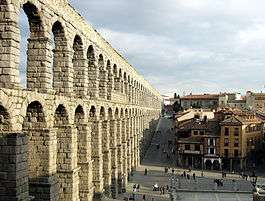Gadara Aqueduct
The Gadara Aqueduct, also called Qanat Fir'aun (Pharaoh's Watercourse), was a Roman aqueduct water supply for some of the Decapolis Cities. It serviced Adraha (known today as Dera'a in Syria), Abila (Decapolis) at Wadi Queilebh in Jordan, and the city of Gadara (modern-day Um Queis in Jordan). The aqueduct has the longest known tunnel of the Classical Era.
In more than 150 kilometers of the land, there was one section of more than 106 km, constructed with the qanat technology. In this special case, nearly all the shafts were diagonal with 45-60 degrees downwards with stairs to the real water channel inside the mountain. The line went along steep slopes and collected water from sources around the area. Together with sidelines to the cities and Siphon Pipe Sections this Roman aqueduct was a really ingenious and unique historic construction. The first visitor who rode along the "Kanatir" was U.J.Seetzen in 1805.
High precision GPS measurements confirm a gentle gradient of 0.3 meters per mile for the underground tunnel section (this means a fall of just 30 centimeters for every mile of tunnel). The aqueduct (also called "the Decapolis Aqueduct") starts at a Roman dam in Dilli, Syria. From there, this part of the Aqueduct line follows the height lines of the topography and crosses several Wadis via 5-10m high bridges. Especially during the last decades, more the 3 kilometers of the remaining substructions were demolished and lost for all times on the Plains between Dilli and Dera'a near the Jordan Border. The best choice to find the Aqueduct Line was the use of a Digital Height Model, taken and worked out from SRTM Data and also the georeferencing of old black and white Satellite Pictures.
East of Adraha was a 35m high Bold Bridge, which is positioned precisely. The remains of the bridge now can be found on the ground of the new "AlSaad" Dam located at the eastern suburbs of Dera'a. Beneath the classical City of Adraha, was the "underground city", this was also a part of the aqueduct. The inhabitants of the city has collected the water by jars on ropes, from the underground channel. Today there is no sign of the "underground City" which was described by Wetzstein in 1860 and G.Schumacher in 1896. After a junction Point with a sidechannel from the Lake of Muzeirib, the underground Long-Aqueduct-Tunnel-Section begins. Near Gadara, 3 different water systems have been found. The first and second were built with qanat technology and the 3rd (described by G. Schumacher, Across the Jordan) was built as a Channel along the old Roman street. It's commonly believed that all 3 Systems were used, but each at a different period. All collected information about the bridges, the dam area, and the ancient cities nearby can be found together with the precise geographical positions at the Qanat Fir'aun or Decapolis Aqueduct
See also
Notes
References
- Mathias Döring: "Roman Water Systems in Northern Jordan", Proceedings of the 12th International Congress on the History of Water Management and Hydraulic Engineering in the Mediterranean Region (Ephesus, Okt. 2004), Österreichisches Archäologisches Institut, Sonderschriften, Vol. 42 (Leuven, 2006), pp. 237–243
- Mathias Döring: "Wasser für Gadara. Römische Fernwasserleitung im Norden Jordaniens, Wasserwirtschaft, H. 8 (2007), pp. 21–25
- Mathias Döring: "Qanat Firaun. 106 km langer unterirdischer Aquädukt im nordjordanischen Bergland, Schriften der Deutschen Wasserhistorischen Gesellschaft, Vol. 10 (2008), pp. 1–16
- Mathias Döring: "Qanat Fir'un - Documentation of the 100 Kilometres Aqueduct Tunnel in Northern Jordan. Annual of the Department of Antiquities of Jordan, Amman/Jordan 2009, pp. 153–165.
- Mathias Döring: "Wasser für die Dekapolis - Jordanisches Bergland birgt längsten bisher bekannten Aquädukttunnel. Ein Zwischenbericht. Deutsches Archäologisches Institut, Forschungs Cluster 2, Berlin 2012, 225-243.
- Mathias Döring: "Wasser für die Dekapolis. Römische Fernwasserleitung in Syrien und Jordanien. Deutsche Wasserhistorische Gesellschaft Vol. S 12, 2016, pp. 1–248, ISBN 978-3-9815362-3-2.
External links
- Rome's tremendous tunnel. The Ancient World's Longest Underground Aqueduct, Spiegel Online
- , Qanat Fir'aun, the more than 150 km long Decapolis Aqueduct in Syria and Jordan, Jens Kleb
International
- Gadara (Jordan), romanaqueducts.info
